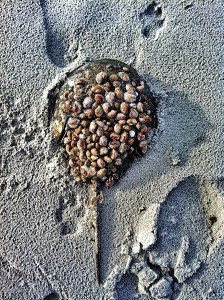
Once a horseshoe crab reaches their full size they stop molting. Their shells then come to host many sessile creatures, including slipper snails.
All horseshoe crabs molt – until they reach adulthood. They grow on average a quarter of their size each time they shed. Females grow to be about two feet across and males a bit smaller. Molting occurs several times during the first few years and slows as they age. It usually takes 17 molts to reach sexual maturity at age 9-11.
Studies have proven that adults do not molt because the age of organisms living of the crab’s shell. For instance, scientists Bottom and Ropes (1988) completed a study to determine that large slipper snails (Crepidula fornicata) were at least 8 years old on a sample of specimens. This would then make the average age of horseshoe crabs in the Delaware Bay to be 17 years old.
Also, the deteriorated carapace of some horseshoe crabs, as well as the presence of internal chitinous rods that hold the carapace in place are also evidence that older horseshoe crabs do not molt.








What people are saying …